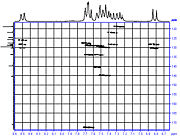2D HMBC
From NMR Wiki
2D HMBC (Heteronuclear Multiple Bond Correlation) experiment correlates chemical shifts of two types of nuclei separated from each other with two or more chemical bonds. This is an improvement of the old COLOC experiment. For example 1H,13C-HMBC correlates chemical shifts of protons with carbons separated with two or three bonds, in some cases even with the more distant ones. The zero and double quantum coherences with lowpass filtration for elimination of the single quantum coherences are usually applied in this experiment.
Chemical shift of one nucleus - usually 1H is detected in the directly measured dimension, while chemical shift of second nucleus (heteronucleus or X-nucleus) is recorded in the indirect dimension.
1H,13C-HMBC is frequently used for assigning of quaternary and carbonyl carbons. In some cases it can be used for assigning -OH protons, and protons bonded to other heteroatoms also. For example, HMBC spectrum of naringin. HMBC experiment is quite prone to different artifacts, like are the 1JCH coupling artifacts, missing of crosspeaks for some C/H pairs, etc. Also, due to the different coupling constants, non equivalent protons bonded to the same nucleus (carbon) can have different pattern of the crosspeaks(i.e crosspeaks with different carbons).
Several betterments was proposed to increase sensivity, reduce artifacts (like 1JCH coupling), measure coupling constants, and others.


